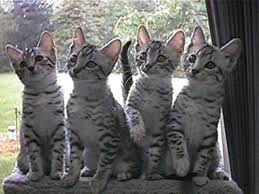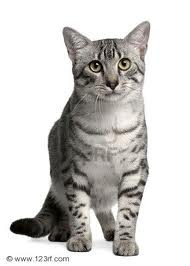There's no record of the origin of the Egyptian Mau cats and it's fraught with uncertainty. It really is, nonetheless, considered to have descended from wild African cats. If one sees walls paintings of Ancient Egypt, one will simply have the ability to identify the ancestors of the modern day day Mau. The word mau literally translates to ‘cats’ inside the Middle Egyptian language.
There are actually no specific kinds of Egyptian Maus.
Physical Attributes of Egyptian Maus
The Egyptian Mau is actually a small to medium sized cat and has slender, muscular bodies. I’s body is randomly spotted and it has banded legs and tails. It has gooseberry green eyes, distinctive mascara lines and a worried expression on the face. It has a graceful cheetah-like stride. Its coat is normally in 1 of these five colors- silver, bronze, pewter, smoke and blue/pewter. It can be the fastest of all domestic cats, thanks to a distinctive skin flap extending from the flank to the back knees.
Egyptian Mau cats are recognized to posses musical voices and can chirp and chortle amongst other sounds. They also do a happy dance when highly joyous. They're incredibly intelligent and loyal. They are regarded as to have a slightly dog like personality.
Caring For Egyptian Maus
Egyptian Mau cats are far more sensitive than other breeds. They need incredibly warm temperatures. They're also likely to be extra sensitive to medicine and anesthesia. They have the longest gestation period of 73 days
Description
Egyptian Maus do bear a resemblance to paintings of ancient Egyptian cats, despite the fact that this does not prove that they're actually of Egyptian origin. The very first documented Maus were brought to the United States in 1956 by a Russian princess named Natalie Troubetskoy. The matriarch of the Egyptian Mau breed was a silver female named Baba.
These active, athletic cats have the randomly-spotted tabby pattern resembling wild cats, but are totally domesticated. In truth, the Mau is the only naturally-occurring pedigreed breed of spotted domestic cat. It really is an intelligent and devoted breed with expressive green eyes and known for a slightly "worried" expression.
They are accepted in colors for example bronze, silver, and black smoke. They had been initial accepted in 1968 by CFF.
Intriguing breed reality: Egyptian Maus are the fastest breed of domestic cat. Maus have been clocked running over 30 mph (48 kph)
Egyptian Maus are a small-medium sized short-haired cat breed. Together with the Bahraini Dilmun Cat, they're 1 of the few naturally spotted breeds of domesticated cat.The spots on an Egyptian Mau aren't only on the coat; a shaved Mau has spots on its skin. The spotted Mau is an ancient breed from natural stock; its look has not changed significantly as is evidenced by artwork over 3000 years old. In contrast to other spotted cats for example the Ocicat or Bengal cat, the Egyptian Mau is actually a natural breed.Other breeds are developed from domestic breed outcross or, inside the case of the Bengal cat, domestic outcrosses with wildcats. The Mau is substantially smaller than these other breeds.
The breed conformation is described by The Cornell Book of Cats as
a balance between the compactness of a Burmese along with the slim elegance of a Siamese. Its medium-length body is muscular, with the hind legs longer than the front, giving the Mau the appearance of standing on tiptoes when upright.
The Egyptian Mau is the fastest of the domestic cats,with its longer hind legs, and special flap of skin extending from the flank to the back knee, delivers for greater agility and length of stride.Maus have been clocked running over 36 mph (58 km/h).
Maus normally possess quite musical voices. They're known to chirp, chortle and emit other distinctly unusual vocalizations when stimulated.
Another behavior, fairly typical in happy Maus, has been described as "wiggle-tail." The cat, male or female, wiggles and twitches its tail, and appears to be marking territory, also known as spraying, however it is not in fact releasing urine. Even veteran Mau owners are recognized to check immediately after a joyous Mau does this small dance
Origins
The exact origin of the Egyptian Mau is not recorded and as a result can not be identified for certain.The Egyptian Mau is frequently stated to be descended from African wild cats.and its ancestor is depicted basically unchanged in wall paintings of Ancient Egypt. The breed name itself references the Middle Egyptian word mau
The modern Mau is said to have originated in 1953, Italy, when exiled Russian Princess Natalie Troubetskaya met the cat of the Egyptian Ambassador to Italy.She convinced him to acquire various cats from Egypt for her, and she began to breed them. From her the Mau has been described as having a "troubled" look, with their round eyes and open expression. The Mau achieved championship status in some organisations in 1968. There were attempts by British breeders to generate Maus from cross-breeds of Abyssinians, Siamese and tabbies, even so these didn't resemble the true Maus. This mix became the basis for the Ocicat.
Egyptian Maus will either have a 'scarab beetle' or 'M' marking on their foreheads,those with the latter tend to be from the United States
Egyptian Maus are generally slender and muscular and they are thought to be 1 of the progenitor breeds of the modern domestic cat.They've anatomical, metabolic, and behavioral differences from other cat breeds which might be considered evidence of antiquity or at least uniqueness from other cat breeds. Some anatomical differences are their legs are slightly shorter within the front than inside the back. They also have a skin fold under the belly, like the cheetah, which assists in running by permitting the legs to stretch back farther.
The typical Mau is known for having what exactly is regarded as a loyal, friendly, but slightly dog-like personality
Maus are extra temperature sensitive than most breeds - they are fond of extremely warm temperatures.They're more sensitive to medicines and anesthesia.[citation needed] Maus allegedly have an unusually lengthy gestational period, about 73 days.The maximum regular period for cats is 65-67 days, even though Siamese could take each day or two longer.
Albeit largely anecdotal, the Egyptian Mau is nicely recognized for intelligence and close bonding with responsible and loving owners. Such owners typically report their Maus eagerly greet them at the door at the end of a long day at work. Usually requiring additional effort than other breeds, Maus could be "lap cats," but their alert nature makes the job difficult. Despite the fact that ill-advised by most veterinarians and animal-care givers, the Egyptian Mau loves an outdoor life. Their speed, coupled with their innate intelligence, permits them to steer clear of virtually all dangers if carefully introduced to an outdoor world really early in life. Unusually averse to loud noises and fast-moving objects, Maus are rarely "road kills," and instead are far too busy decimating the mouse and rat population inside the back yards and farms of your neighbors. Lots of responsible farmers report that a couple of Mau crossbreeds have saved whole crops from rodents. The typical Mau just isn't social with strangers of any species, other cats in specific. As kittens, maus will also test out their capacity to attack and scratch. Supplying them with big sausage-like dog toys so they can practice "gutting" and "killing" is really a ought to if you would like your cat to be a ratter. Also, they are very difficult to wash for those who don't have thick gloves or thick skin. Maus will fight trespassing cats with astonishing ferocity and uncannily disappear from strange and loud humans. Accordingly, the Egyptian Mau is not an excellent option for an absentee condo owner who, when house, brings in strange pets and humans. But over-all, the Mau is a great pet known for creating a special and powerful bond with typically one or two people in the family.
Rarity
Egyptian Maus are a comparatively rare breed to encounter. As of 2007, fewer than 200 kittens are registered with the GCCF each and every year.
As of 2006, a total of 6741 Maus are registered with the CFA. Maus come in five colors. From most to least prevalent these colors are: silver, bronze, smoke, black and blue/pewter.
Black and pewter Maus can not be shown, but may perhaps be used in breeding. All Maus need to have green eyes, but an amber cast is acceptable in kittens and young adults up to eighteen months old.
Egyptian Mau Rescue Organization
 |
| Egyptian Mau Cat Breed |
EMRO is an adoption agency both locally and internationally for tame Maus. Supported solely by private and corporate donors, EMRO aims to enhance education, in Egypt and all over the world, about cats.EMRO's cats are not pedigreed Egyptian Maus; they are Egyptian and Arabian street cats of unknown pedigree.
The only cats that will be legitimately called Egyptian Maus are cats that have registration papers from a reputable registry that certify them as such. Despite the fact that EMRO's cats come from the Egyptian Mau's present region of import, CFA, the world's largest registry of pedigreed cats, will not look at these cats and their offspring Egyptian Maus unless they have met numerous exacting requirements to rule out disqualifying physical traits and detailed record-keeping to verify parentage.
The first generation imported cats themselves are regarded as to be Native Maus and their second and third generation offspring are considered Domestic Maus. Lastly, the fourth generation cats are eligible for placement on the active registry supplied they have been totally evaluated and approved by a designated representative of the Egyptian Mau Breed Council.
Specifically Type of Cats Egyptian Mau Breed
Specifically Type of Cats Egyptian Mau Breed










0 komentar:
Posting Komentar